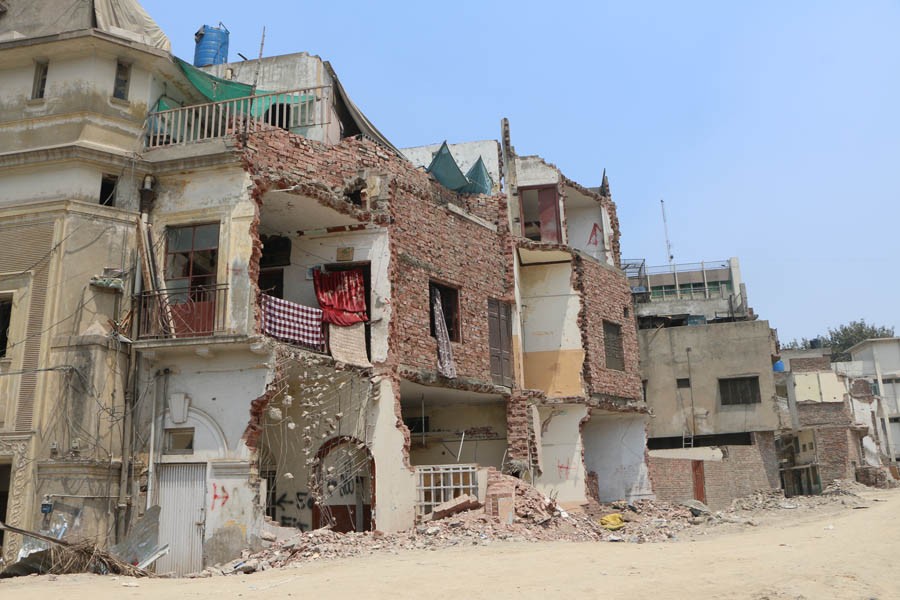
A chat with visual artist Rida Fatima, whose latest work provokes the audience to empathise with those "who lost their homes to the so-called urban development"

"I saw façades after façades of houses being razed to the ground, and thought to myself how heartrending this must’ve been [for the inmates]," says Rida Fatima, a young installation artist who was deeply moved by the plight of those forced to vacate or lose their homes because the Punjab government needed to acquire land for its ongoing Orange Line Metro Train (OLMT) project.
"Is that your idea of urban development?" she asks intently. "I believe that once the exterior -- be it of a building or a person -- is destroyed, everything stands exposed and vulnerable."
In an exclusive chat with TNS, following her much appreciated solo exhibition, titled ‘Deception of Souvenir,’ at Shakir Ali Museum, Fatima reveals how she just picked up her mobile phone and started "documenting the destruction and human suffering, before developing it into relief sculpture." Her art pieces stand out as replicas/models of the houses, complete with their façades.
She says she wanted to stay as close as possible to the original, hence she used the traditional construction materials like concrete, wood, metal, and dyes. "The project took a year and half to complete. It required a lot of sweat and labour."
Fatima was also looking at the larger picture: "I wanted to explore the intricate relationship between rural and urban locales, and see how urban development is impacting the former."
Currently teaching at the National College of Arts, where she also completed her Master’s degree in visual arts last year, Fatima decides to take me to some of the places that became her subjects for the show. On a surprisingly breezy May morning, we begin to walk towards the ill-fated Baba Mauj Darya shrine, whose premises were also encroached upon in order to make way for an OLMT terminal, exploring the area that had been reduced to nothingness.
The first house Fatima stops by belongs to Khalida Bibi, a middle-aged lady. Bibi refused to leave her home, and resisted even after its façade was forcibly destroyed.
"She had nowhere to go," recalls Fatima. There’s a huge pile of rubble lying at its threshold now.
As we go further down, into the narrow cross streets of Purani Anarkali, Fatima says, "I would come here every day, take pictures, talk to people, listen to their stories of pain and affliction, and stand there helplessly while their homes were pulled down."
Explaining what the concept of property is for these people, Fatima says: "You have a special bond with your property; it is hard to part with it. Obviously, the government did not consider the people’s emotional attachment with their homes. My work is a comment on the situation. Through it, I want my audiences to try and go through the memories of the people who lost their homes to the so-called urban development."
Renowned artist and conservationist Ajaz Anwar who happened to view Fatima’s work, speaks highly of it and says that the "government of Punjab wronged these people. Many lives were destroyed, the monetary compensation notwithstanding. Losing your ancestral home is a traumatic experience. The government has fallen prey to majoritarianism."
Compensation for the dislocated was a big issue, right from the beginning of the show, as most houses were joint family residences, and many families lived as one unit. Generally, the houses were built over a land of 3 to 4 marlas each, and the ‘owners’ did not have the original property deeds as they had been living there for ages, and the property was passed down through generations.
Khawaja Ahmed Hassan, Chairman of Steering Committee, Orange Line Metro Train, insists that those whose lands were acquired were paid hefty amounts of money so that they could start a comfortable life in another location.
A man in the area of the Mauj Darya shrine also complains that the area around the monument has been affected. He says the government demolished the attached mosque; the residents want the government to rebuild it as it is a 500 years old monument.
Fatima looks at her work as a way to protest the injustices being committed to the people in the name of urban development. It is interesting to note that once she had completed the sculptures, she showed these to the affectees.
Has she moved on to her next project? Rida Fatima says she is thinking of highlighting the heritage sites that have been affected by the OLMT.